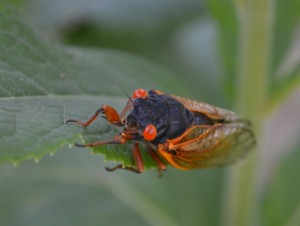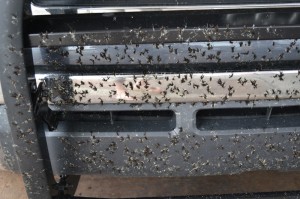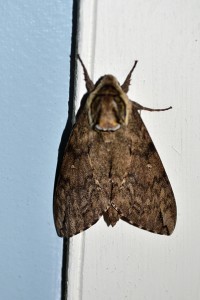You’ve probably heard that the 17-year cicada is due to emerge this summer, mostly in the Eastern U.S. They will rise out of the burrows they’ve occupied since 1996, then mate, then die. After living underground such a long time, and with death so near, they deserve to have some fun in the open air. Eros and Thanatos and all that.
In 2011, as we traveled the longest road from Key West, Florida to Prudhoe Bay, Alaska, we met the 13-year species on a farm in Missouri. There must have been a million of them on that one small farm – talk about biomass – and the males’ mating call rose to a high-pitched shriek that sounded like a hundred skill saws striking a hard knot at the same time. The noise actually got inside our heads. Everywhere lay the corpses of the boys who’d done their reproductive duty, their big orange eyes bulging like miniature pumpkins.
Earlier, in Florida, we encountered another type of insect also impelled by the urge to merge: Plecia nearctica Hardy, commonly known as the Love Bug, the Honeymoon Fly, or the Double-Headed Bug. They mate in mid-air—backwards, the male facing one direction, the female the other (hence, the double-headed nickname). She is the larger of the two, and tows the male along—a kind of insect dominatrix. These creatures boil out of swamps and roadside ditches in such numbers that driving through them is like driving through a blizzard. In no time at all, your windshield is so plastered with dead Love Bugs that you can barely see the road. Every half hour or so, you have to stop to replenish your washer fluid and scrape them off your grill. If you don’t, their highly acidic bodies will clog your car’s radiator and cause the engine to overheat.
The Monster of Them All
The ubiquitous mosquito was with us all the way, from the Everglades to the Arctic tundra. Ticks plagued our campsites in the South and Midwest. But for sheer horror the bath house in a backwoods Tennessee campground won the gold medal. The light outside was dimmed by a nimbus of flies, gnats, and other winged things only an entomologist could have identified. Inside, dead cockroaches littered the floor, while live ones slipped through cracks in the shower stall. Clinging to the walls were moths such as we had never seen; they were as big as house finches. One was bigger yet, a sci fi moth that might have been born in some radioactive waste dump. Leslie named him “Mothra.”
If you have any buggy tales to tell from your road trips, feel free to share them here.
Read more about cicadas in this 1-page New York magazine overview.








I am glad California is not too buggy. The mosquitos can be annoying, but that’s about it. I recall a drive into Souix Falls, Idaho when I had to stop and clean green slimy grasshopper bits off my windshield every 50 miles. It seemed so wicked to be driving through their flyway.